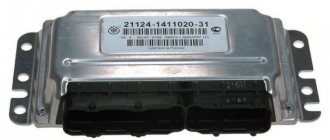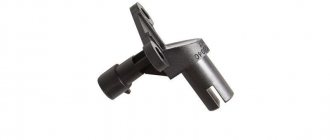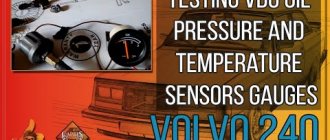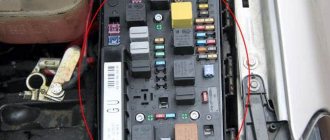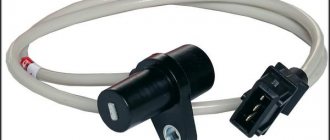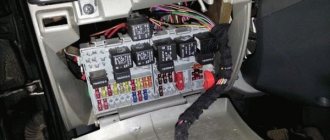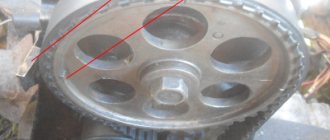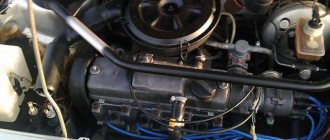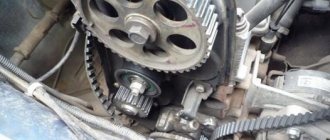If the VAZ 2109 body is in good condition, then after the power unit has exhausted its service life, the owners are faced with the choice of a new engine. And since carburetor versions are no longer produced, installing an injection version will require a complete replacement of the standard electrical wiring.
To replace the motor you will also need a new wiring kit.
For reference: in a carburetor engine, fuel was mixed with air by an air flow, and only then entered the cylinders. In the injection system, it is supplied directly to the cylinders using electronically controlled injectors.
VAZ 2109: sensors on the engine, their location and replacement
The Nine managed to make a lot of noise among the people, in the 90s “bandits” drove it, and in the 2000s it was used by young people, but even today there are more than enough of these cars.
Initially, in 1993, the VAZ 2109 was equipped with a carburetor engine, but progress did not stand still and in the late 90s the nine received an injection engine, which had a positive effect on its technical characteristics. As you know, for proper and reliable operation, an injection engine requires a large number of sensors and a “brain” that will manage it all. There are a lot of sensors on the VAZ 2109 and they are all interconnected in their own way.
This article will focus specifically on the sensors of the injector system on the VAZ 2109, namely, their purpose, location and signs of malfunction.
Electronic engine control unit
The engine control unit is responsible for the operation of almost the entire car. In this part, hundreds of processes are calculated, all readings from sensors installed on the car are processed. Many people call the ECU a “computer” and it’s impossible to disagree with this. The unit, receiving readings from the sensors, processes them and controls the engine, adjusting the supply of fuel and air to the combustion chamber.
Location
The engine control unit on the VAZ 2109 is located under the glove compartment at the feet of the front passenger. You can see it by looking under the panel; the block is closed with a special plastic cover.
Signs of malfunction:
Problems with the operation of the sensor are most often associated with damage to the microcircuit, for example, burnout of a track or damage to one of the radio components, due to which one of the cylinders may fail, etc. It is quite difficult to judge the failure of the ECU based on its symptoms, since they are all similar to the failure of one of the sensors, so the malfunction of the unit can only be determined by diagnosing, disassembling, or replacing it with a known good one.
Location of components and parts on the injection car VAZ-21099
Front-wheel drive VAZ cars are very popular in Russia due to their high maintainability, relatively low cost of spare parts, and simple design. But due to the large number of modifications, it is not easy for the driver to understand even the instructions where this or that unit (part) is located, in particular, on the VAZ-21099 car the injector.
Before repairing a car, some parts have to be searched for a long time and painstakingly, thus wasting a lot of time. In this article we will help you figure out where this or that device is located on the VAZ model 21099, and we hope that the information will be to some extent useful to car owners who have just bought a car, or to novice drivers.
Where is the fuel pump located on the VAZ-21099 injector
Removing and installing a gasoline pump (PG) is not a difficult job and does not require extensive plumbing experience or high qualifications. But if you don’t have to look for a fuel pump on carburetor cars for a long time (it is located on the engine, under the hood), then a beginner may not find it on the injector on the first try. Where is the fuel pump located on the VAZ-21099 sedan injector? Let's figure it out step by step:
- we move the front seats in the car forward as much as possible to free up space in the rear;
- open the rear left door of the car, find a small hinge on the rear sofa, which is located at the junction of the “seats” approximately in the middle of the cabin;
- pull the loop up, thereby raising the back of the lower seat;
- under the carpet we see the gas tank flap;
- unscrew the two fastening screws, remove the hatch and find the fuel pump underneath.
Speed sensor
With the transition of the nine to an injector, the measurement of vehicle speed began to be carried out not mechanically, using a special sensor that reads readings from the rotation of the gearbox gears, transmitting the readings to the computer. The block processes the readings from the sensor and sends signals to the speedometer.
Location
The VAZ 2109 speed sensor is located on the gearbox housing, you can see it by looking under the thermostat and you can find this sensor next to the gearbox dipstick.
Signs of malfunction:
Muffler
Sometimes an injection car does not want to start due to shedding of the catalyst in the muffler. It serves to reduce harmful emissions and is installed in accordance with current environmental legislation on all cars.
When the catalyst crumbles, the gases cannot escape normally, which means that the car will not move, since the computer will not allow it to start. It is not difficult to check this possibility - unscrew the muffler mount so that the exhaust comes directly from the resonator. If this helps, then change the catalyst.
Knock sensor
The knock sensor on the nine is used to detect detonations in the engine that occur due to low-quality fuel. These detonations can cause serious damage to the engine if they are not corrected in time, which is exactly what the knock sensor does. It detects detonation, then sends a signal to the ECU, which adjusts the ignition timing, thereby reducing detonation in the engine.
Location
The knock sensor is located on the block in the middle, it can be seen between the 2nd and 3rd cylinders.
Signs of malfunction:
Where is the starter relay located?
Just like the engine cooling fan, the starter is controlled by a relay, and its malfunction can cause problems:
- when you turn the ignition key, nothing happens, the engine does not show any signs of life;
- When I try to start the engine, clicks are heard, but the starter does not crank.
Finding out where the starter relay is located on a VAZ-21099i car is very simple; to do this, you just need to open the hood of the car and look behind the air pipe of the injection engine; the part you are looking for is shown below in the picture.
Fuel system
If there is a spark in a carburetor or injection engine, it should be assumed that the car does not start due to problems in the fuel supply system.
First make sure that gasoline is flowing into the injectors. If not, then look at the VAZ fuel pump. It is equipped with an electric motor and is located directly in the tank. Normally, when the ignition is activated, it starts to make noise.
It is advisable to find out whether the pressure in the ramp is normal. Measure it with a pressure gauge - there is a special fitting for it. Connect the device to it - if the reading is 4 atmospheres, then everything is in order. Low pressure appears due to a clogged fuel filter; this element will have to be removed and cleaned.
If there is no positive result, move on to the injectors. When they become clogged, gasoline either stops flowing altogether or its volume noticeably decreases. Moreover, it does not spray, but only drips. This problem does not make itself felt while the engine is hot. In frosty weather, the car, even if it starts moving, will still not be able to develop normal power.
In addition, fuel atomization does not occur when the computer does not open the injectors. Make sure they have all the wires and are securely attached.
How to check the hall sensor on a VAZ 2109 carburetor
Well, in general, I’m sitting here now, and I feel that anger is growing inside me towards those people who, apparently, do not understand how the contactless ignition system works and are trying to squeeze something out of themselves, insert their two cents, so to speak, into conversation. If you are one of them, then read carefully. Such experts claim that if there is no spark at the center (high-voltage wire from the coil to the distributor, that is, the distributor), then the hall sensor has nothing to do with it.
Let me ask you, why do you think a Hall sensor is needed? Is it possible to throw a spark through the cylinders? For this purpose there is a slider and a distributor cover. The Hall sensor is the initial stage of spark formation (!). Now I will try to explain clearly with an example. On the distributor roller there is a screen with slots as seen in photos 1 and 2. When this roller (and the screen, respectively) rotates, these slots (indicated with a screwdriver in the second photo) pass through the gap of the Hall sensor (indicated with a screwdriver in photo 3), resulting in the formation an impulse that then goes to the switch, then from the switch goes an impulse to the ignition coil, and then a spark comes from the coil! If the Hall sensor does not send a pulse, the switch will fail.
There is a fairly simple method that allows you to accurately verify that the Hall sensor is faulty: Turn on the ignition (do not turn the starter), remove the mother (chip) from the Hall sensor (photo 4), take a screwdriver or something else and short the middle wire to ground ( in my case there are only two wires, no one knows where the third one went
